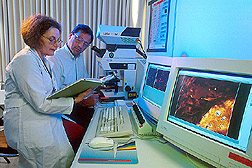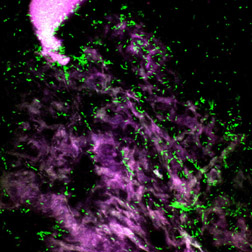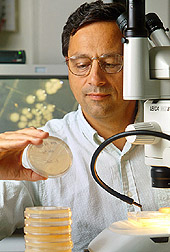Curtailing Campylobacter |
|
|
|
If a microbe is able to cling to the surface of a food, it may use that site as the launching point for a successful invasion. But what if the natural mechanisms that enable microbes to establish these beachheads could somehow be undermined? That's the goal of new investigations by ARS research microbiologist Robert E. Mandrell and colleagues. They are with the ARS Food Safety and Health Research Unit at the Western Regional Research Center, Albany, California. Scientists have known for decades that Campylobacter jejuni, a food-poisoning microbe, sticks to poultry skin. "But," Mandrell admits, "we don't know the details. We don't know what genes are activated when the microbe first comes in contact with the skin. We suspect that specific molecules in the skin act as receptors that the pathogen can bind to, but we don't know that for certain. Nor do we know how many different kinds of receptor molecules are involved," he says. "Most important, we don't yet know what we can do to make the receptors fail." |
|
|
Major Cause of Food Poisoning Campylobacter causes about 2 million human illnesses, 10,000 hospitalizations, and 100 deaths a year, according to estimates from the Centers for Disease Control and Prevention. Preliminary experiments at the Albany laboratory have Campylobacter binds to and have shown how quickly the connection happens. For these tests, Mandrell and co-researchers exposed extracts of ground-up chicken skin to various strains of C. jejuni, the Campylobacter species of most concern. Eight of the nine C. jejuni strains bound to a fat-containing compound, or phospholipid, known as sphingomyelin. Fewer strains bound to other phospholipids, such as phosphatidylcholine. In addition, more Campylobacter cells bound to sphingomyelin than did cells of another foodborne pathogen, Salmonella. |
|
|
Affinity for a Protein
In another test, the researchers examined a mixture of proteins—found in chicken skin and known as proteoglycans. All 12Campylobacter strains examined bound to proteoglycans. And, reports Mandrell, the microbes bound more snugly to a proteoglycans mixture than to a purified sample of one specific proteoglycan, collagen.Campylobacter bound to proteoglycans within 2 minutes after being exposed to the mixture, Mandrell says. Within about 20 minutes, the pathogen formed large colonies. Mandrell did the work with Anna H. Bates, David L. Brandon, Amy O. Charkowski, Gary A. McDonald, and William Miller of the Albany team. Earlier studies, done elsewhere, had already shown thatCampylobacter can bind to proteoglycans. But the Albany experiments were apparently the first to use proteoglycans extracted from actual chicken skin. The team's research has revealed differences in the affinity of variousCampylobacter strains to the natural mixture of proteoglycans as well as differences in how fast the binding takes place. Other scientists have speculated that proteins or fats in meats may act as receptors, helpingCampylobacter to stick. The Albany investigations suggest that proteoglycans and phospholipids such as sphingomyelin may play that role in poultry.Markers Trace Microbe's Invasion To trackCampylobacter cells on chicken skin, research microbiologist William Miller uses a fluorescence-imparting gene from the Pacific jellyfish,Aequorea victoria. He paired that gene with a portion of aCampylobacter gene called a promoter, to turn on the jellyfish gene. Miller then moved the pair intoCampylobacter cells. The transformedCampylobacter cells continuously glow vivid yellow, brilliant green, or bright blue-green—colors that are easy to see under ultraviolet light in the lab. Having an array of different colors enables the scientists to spy on the progress of multiple strains or multiple species ofCampylobacter at once. That's important because more than one kind ofCampylobacter might be living in or on a chicken at one time. In fact, this color-coding option has already helped the team. Using it, they found new evidence that different strains ofCampylobacter—each sporting its own color in the experiments—can coexist as an aggregate. "Without this distinguishing coloration," says Miller, "cells isolated from these aggregates could easily be mistaken for a single, pure strain. It's important to know whether a colony is made up of more than one strain," he points out, "because each strain may behave somewhat differently. To zap each strain, you might need to use more than one technique." Miller collaborated in this work with Bates, Mandrell, Maria T. Brandl, and Sharon T. Horn at Albany, and with Marian R. Wachtel, formerly at Albany and now with ARS at Beltsville, Maryland. More Promoters Observed In other investigations, Miller and colleagues are linking the jellyfish gene to an assortment of several hundred other Campylobacter promoters. The intent: to pinpoint Campylobacter genes that are key in helping the microbe stick to skin and survive on or inside poultry. Unlike the promoters that cause Campylobacter cells to glow nonstop, this second series of promoters is configured to turn on the jellyfish gene only when the promoters receive signals from Campylobacter cells. "Let's say Campylobacter cells with a particular promoter inside begin to glow as they start attaching to chicken skin," says Miller. "That probably means this Campylobacter promoter is normally configured with a Campylobacter gene that's in some way involved with helping the bacteria adhere. Once we've identified these critical genes, we may be able to block their activity." Scientists have used fluorescence-imparting genes from the Pacific jellyfish since at least 1994. Miller's work has shown that fluorescing Campylobacter cells are faster and easier to use than some other options.—By Marcia Wood, Agricultural Research Service Information Staff. This research is part of Food Safety and Health, an ARS National Program (#108) described on the World Wide Web at http://www.nps.ars.usda.gov. To reach scientists mentioned in this article, contact Marcia Wood, phone (510) 559-6070, fax (510) 559-5882. |
|
"Curtailing Campylobacter" was published in the July 2001 issue of Agricultural Research magazine. |









